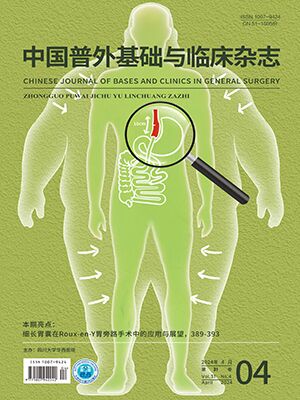| 1. |
Parkin DM, Bray F, Ferlay J, et al. Estimating the world cancer burden: Globocan 2000 [J]. Int J Cancer, 2001; 94(2)∶153.
|
| 2. |
Zhou XD, Tang ZY, Yang BH, et al. Experience of 1 000 patients who underwent hepatectomy for small hepatocellular carcinoma [J]. Cancer, 2001; 91(8)∶1479.
|
| 3. |
Taketa K. Alpha-fetoprotein: reevaluation in hepatology [J]. Hepatology, 1990; 12(6)∶1420.
|
| 4. |
Mackay A, Jones C, Dexter T, et al. cDNA microarray analysis of genes associated with ERBB2 (HER2/neu) overexpression in human mammary luminal epithelial cells [J]. Oncogene, 2003; 22(17)∶2680.
|
| 5. |
Taniwaki M, Daigo Y, Ishikawa N, et al. Gene expression profiles of small-cell lung cancers: molecular signatures of lung cancer [J]. Int J Oncol, 2006; 29(3)∶567.
|
| 6. |
Welsh JB, Zarrinkar PP, Sapinoso LM, et al. Analysis of gene expression profiles in normal and neoplastic ovarian tissue samples identifies candidate molecular markers of epithelial ovarian cancer [J]. Proc Natl Acad Sci USA, 2001; 98(3)∶1176.
|
| 7. |
Young AN, Amin MB, Moreno CS, et al. Expression profiling of renal epithelial neoplasms: a method for tumor classification and discovery of diagnostic molecular markers [J]. Am J Pathol, 2001; 158(5)∶1639.
|
| 8. |
Hegde P, Qi R, Gaspard R, et al. Identification of tumor ma-rkers in models of human colorectal cancer using a 19,200-element complementary DNA microarray [J]. Cancer Res, 2001; 61(21)∶7792.
|
| 9. |
Iacobuzio-Donahue CA, Maitra A, Shen-Ong GL, et al. Disc-overy of novel tumor markers of pancreatic cancer using global gene expression technology [J]. Am J Pathol, 2002; 160(4)∶1239.
|
| 10. |
Xiao SY, Wang HL, Hart J, et al. cDNA arrays and immunohistochemistry identification of CD10/CALLA expression in hepatocellular carcinoma [J]. Am J Pathol, 2001; 159(4)∶1415.
|
| 11. |
Pergolizzi JV Jr, Auster M, Conaway GL, et al. Cryosurgery for unresectable primary hepatocellular carcinoma: a case report and review of literature [J]. Am Surg, 1999; 65(5)∶402.
|
| 12. |
Nobata S, Shinozawa T, Sakanishi A. Truncated midkine induces transformation of cultured cells and short latency of tumorigenesis in nude mice [J]. Cancer Lett, 2005; 219(1)∶83.
|
| 13. |
Koide N, Hada H, Shinji T, et al. Expression of the midkine gene in human hepatocellular carcinomas [J]. Hepatogastroenterology, 1999; 46(30)∶3189.
|
| 14. |
Ikematsu S, Yano A, Aridome K, et al. Serum midkine levels are increased in patients with various types of carcinomas [J]. Br J Cancer, 2000; 83(6)∶701.
|
| 15. |
Ikematsu S, Okamoto K, Yoshida Y, et al. High levels of urinary midkine in various cancer patients [J]. Biochem Biophys Res Commun, 2003; 306(2)∶329.
|
| 16. |
Filipenko NR, MacLeod TJ, Yoon CS, et al. Annexin A2 is a novel RNA-binding protein [J]. J Biol Chem, 2004; 279(10)∶8723.
|
| 17. |
Laumonnier Y, Syrovets T, Burysek L, et al. Identification of the annexin A2 heterotetramer as a receptor for the plasmin-induced signaling in human peripheral monocytes [J]. Blood, 2006; 107(8)∶3342.
|
| 18. |
Gillette JM, Chan DC, Nielsen-Preiss SM. Annexin 2 expression is reduced in human osteosarcoma metastases [J]. J Cell Biochem, 2004; 92(4)∶820.
|
| 19. |
Tatenhorst L, Rescher U, Gerke V, et al. Knockdown of annexin 2 decreases migration of human glioma cells in vitro [J]. Neuropathol Appl Neurobiol, 2006; 32(3)∶271.
|
| 20. |
Yoon SY, Kim JM, Oh JH, et al. Gene expression profiling of human HBV- and/or HCV-associated hepatocellular carcinoma cells using expressed sequence tags [J]. Int J Oncol, 2006; 29(2)∶315.
|
| 21. |
Dorr SN, Schlicker MN, Hansmann IN. Genomic structure of karyopherin alpha 2 (KPNA2) within a low-copy repeat on chromosome 17q23-q24 and mutation analysis in patients with Russell-Silver syndrome [J]. Hum Genet, 2001; 109(5)∶479.
|
| 22. |
Teng SC, Wu KJ, Tseng SF, et al. Importin KPNA2, NBS1, DNA Repair and Tumorigenesis [J]. J Mol Histol, 2006; [Epub ahead of print].
|
| 23. |
Dahl E, Kristiansen G, Gottlob K, et al. Molecular profiling of laser-microdissected matched tumor and normal breast tissue identifies karyopherin alpha 2 as a potential novel prognostic marker in breast cancer [J]. Clin Cancer Res, 2006; 12(13)∶3950.
|
| 24. |
Winnepenninckx V, Lazar V, Michiels S, et al. Gene expression profiling of primary cutaneous melanoma and clinical outcome [J]. J Natl Cancer Inst, 2006; 98(7)∶472.
|




